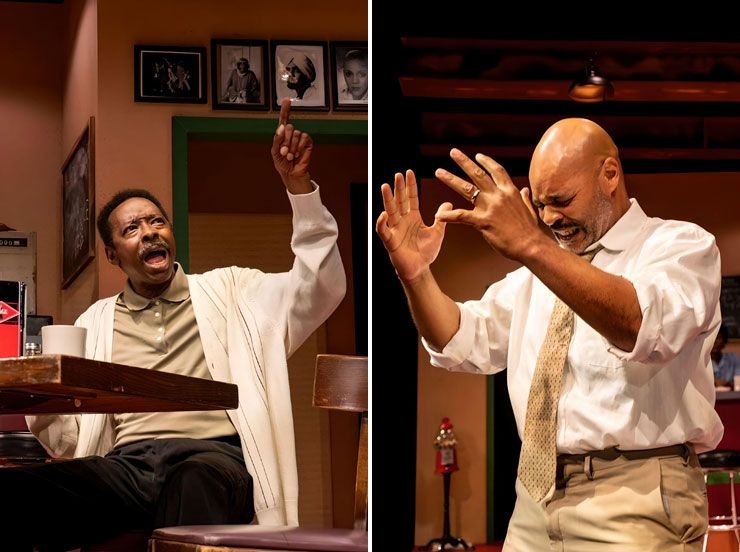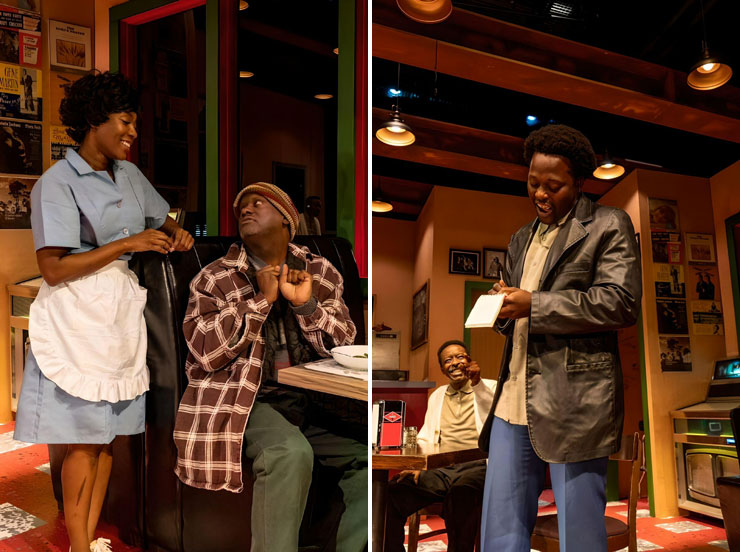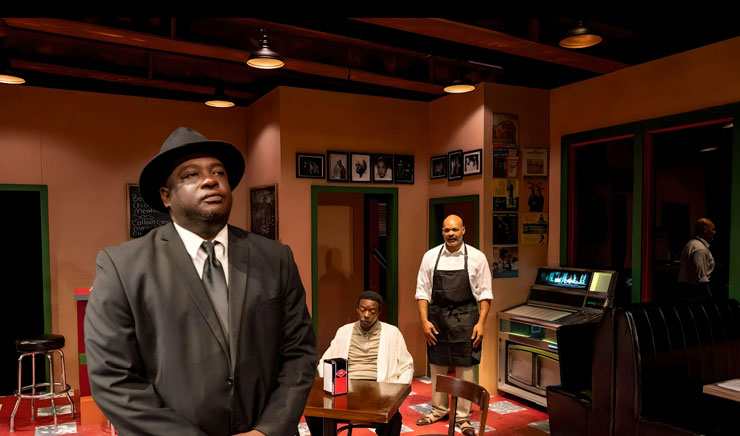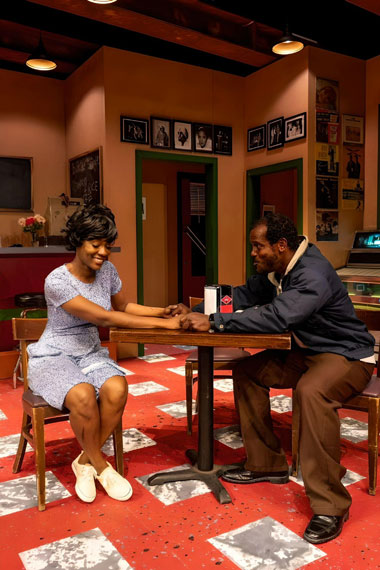
LEFT: Chat Atkins plays the opinionated Holloway in M Ensemble's "Two Trains Running." at the Sandrell Rivers Theater through May 28. RIGHT: Melvin Huffnagle as restaurant owner Memphis in M Ensemble's "Two Trains Running." (Photos by Christa Ingraham)
Part of the late, great playwright August Wilson’s appeal is that, while he writes about circumstances specific to African Americans, his work speaks to audiences regardless of their race or background.
For instance, most of us take pride in our accomplishments and feel that they are worth something. In Wilson’s compelling play, “Two Trains Running,” Memphis Lee is no different.
He owns a small restaurant in Pittsburgh’s Hill District of the 1960s. It is a poor, Black community where most of Wilson’s plays take place.
Lee, “Two Trains Running’s” central character, plans to sell his building to city officials so that they can demolish the restaurant to pave the way for a new development. And Lee will not settle for a penny less than the $25,000 to which he thinks he is entitled.
Certainly, Lee’s pride, insistence, and other strong emotions are on vivid display in the award-winning, highly respected M Ensemble Company Inc.’s riveting professional production of “Two Trains Running.” The deftly acted, directed, and designed production runs through Sunday, May 28 in the company’s intimate Sandrell Rivers Theater in Miami.
André L. Gainey, M. Ensemble’s Artistic Director, smartly and sensitively directs seven talented actors in the believable production. For example, after Lee (a terrific Melvin Huffnagle) insists that he will not take a penny less than $25,000, he slaps his thigh and moves confidently, accentuating his unyielding demand.

LEFT: Pamela Hankerson as Risa and Keith C. Wade as Hambone in M Ensemble's "Two Trains Running." RIGHT: Jean Hyppolite is numbers runner Wolf and Chat Atkins is Holloway in M Ensemble's "Two Trains Running." (Photo by Christa Ingraham)
Huffnagle delivers a volcanic yet believable performance as Lee. In fact, the effort calls to mind Lester Purry’s towering and believable performance as the highly complex Troy Maxson in Palm Beach Dramaworks’ excellent 2019 production of Wilson’s Pulitzer Prize and Tony Award winning play, “Fences.”
While Maxson lives in Pittsburgh’s Hill District of the 1950s, Lee inhabits the same community in 1969. Both characters populate plays that are part of Wilson’s “Pittsburgh Cycle,” or “Century Cycle.” Specifically, in one of American theater’s greatest accomplishments, Wilson (1945-2005) wrote one play for each of the 20th century’s decades, chronicling the African American experience in each. Wilson, a two-time Pulitzer Prize-winning playwright, completed the project in a period of more than 20 years and included overlapping themes and characters such as the possibly mythical spiritual adviser Aunt Esther, said to be more than 300 years old. While she does not appear physically in “Two Trains Running,” at least one character seeks her help.
Except for one cycle play, “Ma Rainey’s Black Bottom,” which depicts African American life in the 1920s in Chicago, the “Century Cycle” takes place in Pittsburgh’s Hill District. Wilson did not write the plays in chronological order. Rather, he first composed the 1979-set “Jitney” in 1982 and finished the last play, “Radio Golf,” set in 1997, before Wilson’s death in 2005.
In the cycle, some plays center on the spiritual, ritualistic aspects of the African American past. However, in works such as the Tony-nominated “Two Trains Running,” realism is predominant.
One of “Two Trains Running’s” central themes is the manner in which the Black community reacted to legal victories of the Civil Rights movement. Specifically, a sense of hopelessness hung over the lives of Blacks living in poor, urban neighborhoods. With many African Americans still struggling daily with meager wages and bleak prospects, they may have felt that equal rights applied to them in theory only.
Undoubtedly, one character in “Two Trains Running” who feels he is receiving unequal treatment is a man Wilson only names Hambone (Keith C. Wade). His complaint, which might seem trivial on the surface, represents the larger struggle of African Americans to receive their fair share of the American Dream.

Ray Lockhart as funeral director West, Chat Atkins as Holloway and Melvin Huffnagle as Memphis in M Ensemble's "Two Trains Running" at the Sandrell Rivers Theatre through May 28. (Photo by Christa Ingraham)
Specifically, a decade before “Two Trains Running” begins, Hambone painted the fence of the meat market across the street from Memphis’s restaurant. At the time, the white owner of the meat market promised Hambone a ham if he did a good job painting the fence. Yet, after Hambone worked hard and completed the job, the owner gave him a chicken instead. Ever since he painted that fence a decade ago, Hambone has gone to the butcher daily expecting his ham, only to be denied each time.
Characters such as Hambone serve as a powerful reminder today that, although we have made progress in ensuring equal rights for African Americans, we have taken steps back. As a matter of fact, 21st century America sometimes eerily resembles scenes from pre-civil rights era America. Indeed, racism is widespread, making plays such as “Two Trains Running” particularly timely.

Pamela Hankerson as Risa and Chaz Reuben as Sterling in M Ensemble's "Two Trains Running." (Photo by Christa Ingraham)
The future does not look especially bright for the play’s other characters, either. For instance, it seems only a matter of time before Sterling lands himself back in prison.
“West gonna get richer and everybody else gonna get poorer,” a character states, bringing to mind today’s gap between the “haves” and “have nots.”
West owns West’s Funeral Home, located across the street from Memphis’s restaurant. West, like the play’s other characters, is Black. However, he is wealthier than the others and seemingly more content. Even so, someone targets him, possibly because of his race, by breaking one of his business’s windows.
The entire action of “Two Trains Running” takes place in Memphis’s restaurant.
Lighting designer Mitchell Ost illuminates the setting realistically, befitting a mostly realistic play. And Geordan Gottlieb constructed the life-like set with period details. Chasity Hart designed the period costumes, which seem appropriate for the characters.
As Memphis, Huffnagle commands the stage while looking natural throughout. The performer, acting stern at appropriate times, leaves no doubt that his character is in charge. He wants to maintain a solid reputation, which Wolf (an impulsive Jean Hyppolite) threatens by essentially operating his illegal gambling gig in the restaurant.
Huffnagle’s Memphis is a proud (but not arrogant), determined man. And he is not about to let the city offer him a penny less than what he feels he deserves in exchange for his restaurant.
In a multi-faceted performance, the actor also vividly conveys his character’s vulnerable side. At one point, real tears well in his wide, dark eyes as Memphis speaks.
Chaz Reuben also shines as ex-convict Sterling, lending the character an impulsive, antsy demeanor that suggests desperation. Indeed, Sterling is desperate to find a job at a time when few employment opportunities existed for poor black individuals.
Through Reuben’s performance, we never sense that Sterling is lazy. Clearly, Sterling is searching for his share of the American Dream, which includes finding a significant other. Frequently, Reuben’s Sterling charmingly flirts with Memphis’s employee, Risa (a quiet, unassuming Pamela Hankerson, who acts assertively and with intensity when necessary.)
In addition, Ray Lockhart lends a quiet dignity and polish to undertaker West, while Chat Atkins imbues Holloway with wisdom and a thoughtful air.
Wilson leaves us with plenty to think about in “Two Trains Running,” including themes such as race, gentrification, freedom, and economic strife. And the multi award-winning M Ensemble Company, Inc., the longest-running African American professional theater company in Florida, triumphs again with its intense yet believable production.
M Ensemble Company’s production of “Two Trains Running” continues through Sunday, May 28 at the Sandrell Rivers Theater at Audrey M. Edmonson Transit Village, 6103 N.W. 7th Ave. in Miami. The parking garage’s address is 6101 N.W. 6th Court. Showtimes are at 8 p.m. Fridays and Saturdays, as well as 3 p.m. Sundays. General admission tickets cost $36, while students and seniors pay $26. To purchase tickets, go to www.themensemble.com, or call (305) 705-3218.




